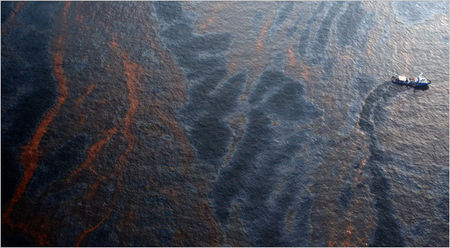Bioremediation of marine ecosystems
Bioremediation of marine ecosystems
Bioremediation is the process where microorganisms transform organic contaminants in oceans, soils, groundwater, sludge and solids, into an energy source. Another process is when they use them as cometabolizing substances with another energy source.[1]
A good example of bioremediation of marine ecosystem is the natural cleanup of oil spills. In many cases the oil is cleaned up over time by the natural processes taking place in marine ecosystems. In case of larger oil spills, human intervention and knowledge about the processes that make natural oil processing possible is necessary. In this case residual oil can be further broken down by an artificial method called biostimulation.[2]
Fig 1. In the case of larger oil spills, residual oil can be further broken down by biostimulation.[3]
Basically there are two large artificial treatment techniques, biostimulation and augmentation.
Biostimulation
Biostimulation refers to the addition of specific nutrients, air, organic substrates or other electron donors/acceptors, nutrients, and other compounds that affect and normally limit treatment in their absence.[1][4] This way the microorganisms will clean the waste source more efficiently and faster than in normal circumstances
Biostimulation is a good technique when all the bacteria needed for the cleaning of a certain waste type naturally occur in the treated environment. Examples of biostimulation are grease accumulation in sewers and grease traps. Grease is a biodegradable substance that can be found in the environment, sewers house a large bacteria population.[4] The substances needed for an efficient cleanup are present: nitrogen and phosphor. In other words, the grease present in sewers should disappear naturally. Paradoxically, grease accumulates in the sewer system. With this in mind, biostimulation won’t work when you want to clean the sewer system. The solution for this problem is bioaugmentation.
Bioaugmentation
Bioaugmentation is a treatment where you want to achieve a controlled, predictable and programmed biodegradation. In other words bioaugmentation is the controlled addition of specially formulated microbial cultures that assist those found naturally in the soil. It is done in conjunction and monitoring of an ideal growth environment in which these selected bacteria can live and work.[4][5]
When considering bioaugmentation, you need to check following reasons of failure.[6] [7]
1. In the field the substrate concentration may be too low to support growth.
2. The system may contain inhibitory substances or be operating at inhibitory growth conditions, such as temperature.
3. Competition with other micro-organisms causes growth inhibition.
4. The inoculants may use other organic substrates in the system rather than the target pollutant.
5. The number of organisms may be too few to cause significant change.
6. The introduced organism is not put into the environment where it can effectively consume the desired substrate. 7. Many supplements are unable to initiate breakdown quickly enough without a period of acclimatization.
If all of the previous reasons of failure aren’t a problem, bioaugmentation is a reasonable strategy.
References
- ↑ 1.0 1.1 http://clu-in.org/
- ↑ Querellou, J. (2010) MarineBiotechnology: A new vision and strategy for Europe. Marine Board-ESF Position Paper 15
- ↑ https://saferenvironment.wordpress.com/2008/09/17/oil-spill-adverse-effects-on-marine-environmental-bio-system-and-control-measures/
- ↑ 4.0 4.1 4.2 http://www.adbio.com
- ↑ Pearce, P. J. (2006) A New Augmentation Method for Bioremediation of Pathogenic Bacteria-Contaminated Water and Sludge. Nova Biologicals, Inc., Conroe, TX, PHD
- ↑ Stephenson, D. and Stephenson, T. (1992) Bioaugmentation for Enhancing Biological Wastewater Treatment. Biotech. Adv., Vol. 10, pp. 549-559
- ↑ Stephenson Environmental Services Limited. (2012) Review of effective microorganisms (EM) and bioaugmentation factors for wastewater biosolids treatment
